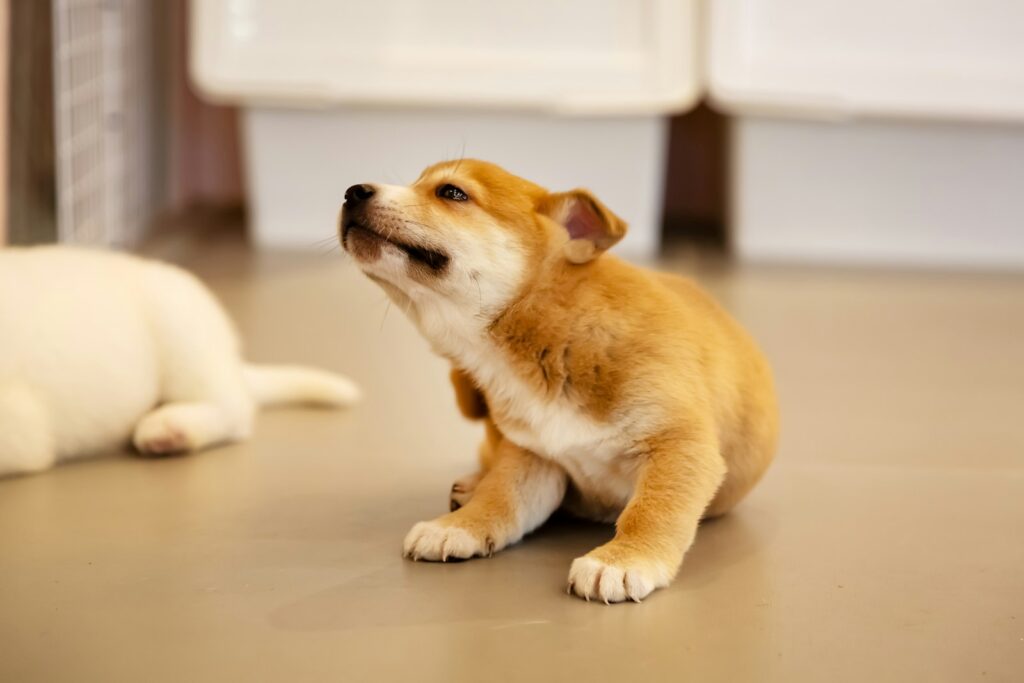15 Signs Your Puppy Might Be Sick

Your dog usually trots over to the door when he sees the leash, gobbles down his dinner, and never has accidents indoors—but lately, things have shifted, and your normally happy pup has been acting a bit off (or even mischievous). Before you start calling him a “bad dog” and taking away toys, take a step back. His unusual behavior could be a sign that something’s wrong. Here are 15 signs that your pup might be sick.
Peeing more or less than usual.

House training your dog was a piece of cake, and they haven’t left a mess on the living room rug in ages—until now. You might think your perfectly potty-trained pup is peeing in the house to get back at you for a long workday, but there could be something else at play. Potty accidents can sometimes point to medical issues. Conditions like kidney disease, tumors, infections, and injuries can cause incontinence.
Throwing up or having diarrhea.

It happens: Dogs sometimes puke or get the runs. But it could also be a sign that something’s up. If your dog throws up or has diarrhea once but is still acting fine and eating like usual, it’s probably just a tummy ache. Keep an eye on them and feed them small amounts of bland, wet food for a day or two until they’re feeling better. Then, slowly start mixing in their regular food.
Not eating like they usually do.

Dogs who are vomiting and have diarrhea or just feeling sick often lose their appetite. If your dog’s not eating, it could mean their stomach’s upset or their mouth hurts. A dog that’s usually picky or just not super hungry might skip the kibble at dinner but would still go for a tasty piece of turkey. But if your dog normally loves food and won’t eat anything, they’re probably not feeling well.
Drinking more or less water than normal.

Sometimes, dogs who aren’t eating well (or other sick pups) will stop drinking water too. But some sick dogs might actually drink more than usual. Both not drinking enough and drinking way more can be signs something’s off, so it’s smart for dog parents to keep track of how often they’re filling up the water bowl.
Limping or struggling to walk.

Dogs who are limping or having problems walking could be dealing with all sorts of conditions. If your dog has been slowly having more trouble walking, going up and down stairs, seems stiff, or keeps slipping on floors, it might mean they have osteoarthritis (which is a pretty common cause of limping and walking issues in older dogs) or another orthopedic problem.
Having seizures.

Like sudden collapse, seizures in dogs can be super scary and a sign of something serious. Sometimes, seizures can make your dog stiffen, collapse, shake, pee, or paddle. But other dogs might have really mild seizures—they might stare off into space and tremble without actually falling down or losing consciousness. Some dogs might even have head tremors, which look like mild seizures but aren’t actually seizures at all.
Pale or odd-colored gums.

Pale gums can be a serious sign that your dog’s dealing with something serious. When we say “pale gums,” we mean gums that aren’t their usual bright pink. Depending on how bad it is, the gums might look light pink, bluish, or even almost white. Some things that can cause pale gums include: anemia, exposure to toxins (like rat poison), shock (from injury), heart problems, and severe dehydration.
Acting differently than usual.

Sadly, our dogs can’t talk and tell us what’s wrong. Instead, they use their body language and behavior to chat with us as best as they can. So when your pup’s feeling sick, he may start acting differently than usual. The way they act can vary depending on the dog and what kind of illness they’re dealing with. Some dogs might show subtle changes, like not wanting to play as much or taking extra naps.
Panting more than usual.

Panting helps dogs cool off when they’re too hot, but constant heavy panting can mean something’s wrong. For example, your dog might be dealing with heatstroke, a painful injury, or could’ve eaten something toxic. Serious health issues like heart failure, Cushing’s syndrome, or breathing problems can also cause heavy panting in dogs.
Suddenly collapsing or being super weak.

Sudden weakness or collapsing is a major red flag and shouldn’t be ignored. If you’re saying things like, “My dog is shaking and can’t stand up,” you need to get to the vet ASAP for an emergency visit. Dogs who collapse are usually dealing with something serious, like heatstroke, heart problems, internal bleeding, seizures, a bad allergic reaction (like anaphylaxis), or low blood sugar.
Smelly breath.

Dogs who aren’t feeling well might also have really stinky breath. If your pup’s got a broken tooth, a loose tooth, an abscess, or bad gum disease, their breath might smell pretty terrible. Dental problems definitely need a vet check, but they’re usually not life-threatening. However, there are some much more serious reasons for bad breath. For instance, dogs with advanced kidney disease can have breath that smells like ammonia.
Coughing or having trouble breathing.

Coughing, wheezing, trouble breathing, and nasal discharge can be signs of cold or dog allergies. But these symptoms could also point to something more serious, like canine flu, kennel cough, tracheal collapse, or heart disease. If the respiratory issues keep going or are paired with other symptoms like tiredness, it’s time to schedule a vet visit.
Red, watery, or puffy eyes.

Your dog’s eyes can really show you how they’re feeling. Red eyes, eye discharge, squinting, puffy eyes, or sticky eyelids could point to all kinds of health issues, from allergies to conjunctivitis to glaucoma. If your dog keeps pawing or rubbing at their eyes, it’s a good idea to take them to the vet and get the eyes checked.
Not wanting to snuggle or be touched.

Is your dog refusing to jump up on the couch? Does he back away when you try to give belly rubs? Sometimes, ignoring commands, acting defensive when you approach, or growling when touched can be a sign they’re uncomfortable with physical contact—and that could mean something’s wrong health-wise. Dogs in pain are often sensitive to touch. So, you need to check for underlying pain or injuries that might make your dog flinch, growl, or twitch.
Eating Poop

There’s nothing that’ll make a pet parent yell, “Bad dog!” faster than seeing their pup munching on poop. This behavior, called coprophagia, is more common than you might think. But it could also be a sign of something like malabsorption syndrome, which makes dogs eat poop to try to get more calories. Besides the obvious “gross” factor, there are some serious risks to eating poop, like picking up parasites.





